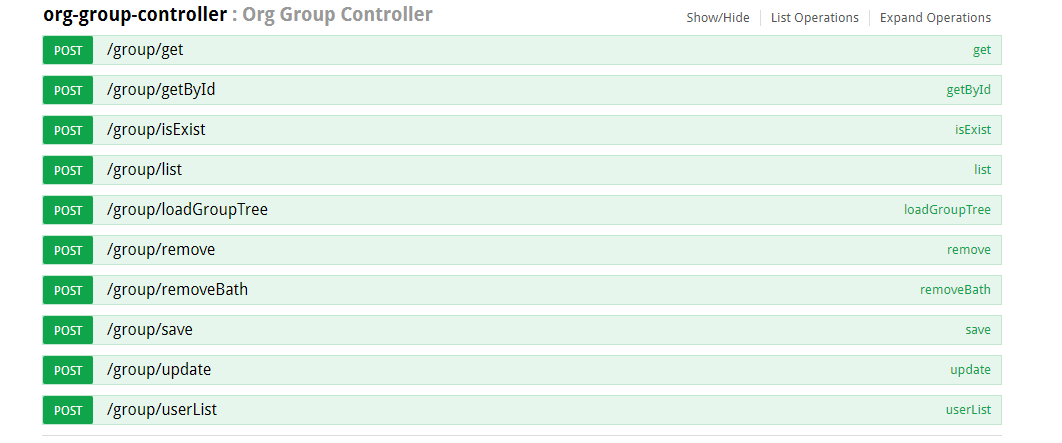在第十章我们完成了对用户管理的集成,本章我们将完成对组织架构管理的集成开发工作,首先打开我们的rbac-produce工程,接着在com/produce/sys/dao目录底下创建一个UserDao.java接口内容如下:
package com.produce.sys.dao;
import com.base.entity.OrgGroup;
import com.base.entity.QueryOrgGroup;
import com.produce.common.base.dao.GenericDao;
/**
*@author linzf
**/
public interface OrgGroupDao extends GenericDao<OrgGroup, QueryOrgGroup> {
/**
* 功能描述:根据父节点来查询最大的节点的值
* @param parentNode
* @return
*/
String getMaxOrgGroup(String parentNode);
/**
* 功能描述:根据菜单节点NODE来查询节点数据
* @param node
* @return
*/
OrgGroup findByNode(String node);
}接着在我们的mapper文件夹底下创建一个mybatis_orgGroup.xml文件,文件内容如下:
<?xml version="1.0" encoding="UTF-8"?>
<!DOCTYPE mapper PUBLIC "-//mybatis.org//DTD Mapper 3.0//EN" "http://mybatis.org/dtd/mybatis-3-mapper.dtd">
<mapper namespace="com.produce.sys.dao.OrgGroupDao">
<resultMap type="com.base.entity.OrgGroup" id="OrgGroupMap">
<id property="groupId" column="group_id"/>
<result property="existingNum" column="existing_num"/>
<result property="groupCode" column="group_code"/>
<result property="name" column="name"/>
<result property="node" column="node"/>
<result property="num" column="num"/>
<result property="parentNode" column="parent_node"/>
</resultMap>
<!-- 根据父节点来查询最大的节点的值 -->
<select id="getMaxOrgGroup" parameterType="java.lang.String" resultType="java.lang.String">
select max(o.node) from org_group o where o.parent_node = #{parentNode}
</select>
<!-- 根据菜单节点NODE来查询节点数据 -->
<select id="findByNode" parameterType="java.lang.String" resultMap="OrgGroupMap">
select * from org_group where node = #{node}
</select>
<!--根据主键获取对象-->
<select id="get" parameterType="com.base.entity.OrgGroup" resultMap="OrgGroupMap">
SELECT group_id,existing_num,group_code,name,node,num,parent_node FROM org_group
WHERE group_id=#{groupId}
</select>
<!--保存-->
<insert id="save" parameterType="com.base.entity.OrgGroup" useGeneratedKeys="true" keyProperty="groupId">
INSERT INTO org_group(existing_num,group_code,name,node,num,parent_node)
VALUES(#{existingNum},#{groupCode},#{name},#{node},#{num},#{parentNode})
</insert>
<!--修改-->
<update id="update" parameterType="com.base.entity.OrgGroup">
UPDATE org_group SET group_code=#{groupCode},name=#{name},node=#{node},num=#{num},parent_node=#{parentNode}
WHERE group_id=#{groupId}
</update>
<!--删除-->
<delete id="delete" parameterType="com.base.entity.OrgGroup">
DELETE FROM org_group WHERE group_id=#{groupId}
</delete>
<!--分页查询-->
<select id="findByPage" parameterType="com.base.entity.QueryOrgGroup" resultMap="OrgGroupMap">
SELECT group_id,existing_num,group_code,name,node,num,parent_node FROM org_group
WHERE 1=1
<if test="existingNum!=null and existingNum!='' " >
AND existing_num=#{existingNum}
</if>
<if test="groupCode!=null and groupCode!='' " >
AND group_code=#{groupCode}
</if>
<if test="name!=null and name!='' " >
AND name=#{name}
</if>
<if test="node!=null and node!='' " >
AND node=#{node}
</if>
<if test="num!=null and num!='' " >
AND num=#{num}
</if>
<if test="parentNode!=null and parentNode!='' " >
AND parent_node=#{parentNode}
</if>
<if test="sort!= null">
order by ${sort} ${order}
</if>
limit #{offset},#{limit}
</select>
<!--统计-->
<select id="count" parameterType="com.base.entity.QueryOrgGroup" resultType="int">
SELECT count(*) FROM org_group
WHERE 1=1
<if test="existingNum!=null and existingNum!='' ">
AND existing_num=#{existingNum}
</if>
<if test="groupCode!=null and groupCode!='' ">
AND group_code=#{groupCode}
</if>
<if test="name!=null and name!='' ">
AND name=#{name}
</if>
<if test="node!=null and node!='' ">
AND node=#{node}
</if>
<if test="num!=null and num!='' ">
AND num=#{num}
</if>
<if test="parentNode!=null and parentNode!='' ">
AND parent_node=#{parentNode}
</if>
</select>
<!--查询-->
<select id="query" parameterType="com.base.entity.QueryOrgGroup" resultMap="OrgGroupMap">
SELECT group_id,existing_num,group_code,name,node,num,parent_node FROM org_group
WHERE 1=1
<if test="existingNum!=null and existingNum!='' ">
AND existing_num=#{existingNum}
</if>
<if test="groupCode!=null and groupCode!='' ">
AND group_code=#{groupCode}
</if>
<if test="name!=null and name!='' ">
AND name=#{name}
</if>
<if test="node!=null and node!='' ">
AND node=#{node}
</if>
<if test="num!=null and num!='' ">
AND num=#{num}
</if>
<if test="parentNode!=null and parentNode!='' ">
AND parent_node=#{parentNode}
</if>
<if test="sort!= null">
order by ${sort} ${order}
</if>
</select>
</mapper>接着在com/produce/sys/service目录底下创建一个OrgGroupService.java实现类内容如下:
package com.produce.sys.service;
import com.base.entity.OrgGroup;
import com.base.entity.QueryOrgGroup;
import com.produce.common.base.dao.GenericDao;
import com.produce.common.base.service.GenericService;
import com.produce.sys.dao.OrgGroupDao;
import org.springframework.beans.factory.annotation.Autowired;
import org.springframework.stereotype.Service;
import org.springframework.transaction.annotation.Transactional;
/**
*@author linzf
**/
@Service("orgGroupService")
@Transactional(rollbackFor={IllegalArgumentException.class})
public class OrgGroupService extends GenericService<OrgGroup, QueryOrgGroup> {
@Autowired
@SuppressWarnings("SpringJavaAutowiringInspection")
private OrgGroupDao orgGroupDao;
@Override
protected GenericDao<OrgGroup, QueryOrgGroup> getDao() {
return orgGroupDao;
}
/**
* 功能描述:根据父节点来查询最大的节点的值
* @param parentNode
* @return
*/
public String getMaxOrgGroup(String parentNode){
return orgGroupDao.getMaxOrgGroup(parentNode);
}
/**
* 功能描述:根据菜单节点NODE来查询节点数据
* @param node
* @return
*/
public OrgGroup findByNode(String node){
return orgGroupDao.findByNode(node);
}
}最后在我们的com/produce/sys/controller底下创建我们的UserController.java实现类内容如下:
package com.produce.sys.controller;
import com.base.common.Page;
import com.base.entity.OrgGroup;
import com.base.entity.QueryOrgGroup;
import com.base.entity.QueryUser;
import com.produce.common.base.constant.SystemStaticConst;
import com.produce.common.base.controller.GenericController;
import com.produce.common.base.service.GenericService;
import com.produce.sys.service.OrgGroupService;
import com.produce.sys.service.UserService;
import org.springframework.beans.factory.annotation.Autowired;
import org.springframework.http.MediaType;
import org.springframework.web.bind.annotation.RequestBody;
import org.springframework.web.bind.annotation.RequestMapping;
import org.springframework.web.bind.annotation.RequestMethod;
import org.springframework.web.bind.annotation.RestController;
import java.util.HashMap;
import java.util.List;
import java.util.Map;
/*
* 类描述:
* @auther linzf
* @create 2018/2/6 0006
*/
@RestController
@RequestMapping("/group")
public class OrgGroupController extends GenericController<OrgGroup, QueryOrgGroup> {
@Autowired
private OrgGroupService orgGroupService;
@Autowired
private UserService userService;
@Override
protected GenericService<OrgGroup, QueryOrgGroup> getService() {
return orgGroupService;
}
@Override
public Map<String, Object> get(@RequestBody OrgGroup entity) throws Exception {
Map<String,Object> result = new HashMap<String, Object>();
entity = orgGroupService.get(entity);
if(entity==null){
result.put(SystemStaticConst.RESULT, SystemStaticConst.FAIL);
result.put(SystemStaticConst.MSG,"获取数据失败!");
}else{
result.put(SystemStaticConst.RESULT, SystemStaticConst.SUCCESS);
result.put(SystemStaticConst.MSG,"获取数据成功!");
entity.setOrgGroup(orgGroupService.findByNode(entity.getParentNode()));
result.put("entity",entity);
}
return result;
}
@Override
public Map<String, Object> update(@RequestBody OrgGroup entity) throws Exception {
Map<String,Object> result = new HashMap<String, Object>();
OrgGroup update = new OrgGroup();
update.setGroupId(entity.getGroupId());
update = orgGroupService.get(update);
update.setName(entity.getName());
update.setGroupCode(entity.getGroupCode());
update.setNum(entity.getNum());
boolean success = orgGroupService.update(update);
if(success){
result.put(SystemStaticConst.RESULT, SystemStaticConst.SUCCESS);
result.put(SystemStaticConst.MSG,"修改数据成功!");
result.put("entity",entity);
}else{
result.put(SystemStaticConst.RESULT, SystemStaticConst.FAIL);
result.put(SystemStaticConst.MSG,"修改数据失败!");
}
return result;
}
/**
* 功能描述:获取组织架构底下的相应的用户
* @return
*/
@RequestMapping(value = "/userList",method = RequestMethod.POST,produces = MediaType.APPLICATION_JSON_VALUE)
public Map<String,Object> userList(@RequestBody QueryUser user){
Map<String,Object> result = new HashMap<String, Object>();
Page page = userService.findByGroupUserPage(user);
result.put("totalCount",page.getTotal());
result.put("result",page.getRows());
return result;
}
/**
* 功能描述:获取组织架构的整颗菜单树
* @return
*/
@RequestMapping(value = "/loadGroupTree",method = RequestMethod.POST,produces = MediaType.APPLICATION_JSON_VALUE)
public Map<String,Object> loadGroupTree(){
Map<String,Object> result = new HashMap<String, Object>();
List<OrgGroup> orgGroupList = orgGroupService.query(null);
result.put(SystemStaticConst.RESULT, SystemStaticConst.SUCCESS);
result.put(SystemStaticConst.MSG,"加载组织机构数据成功!");
result.put("data",orgGroupList);
return result;
}
@Override
public Map<String, Object> save(@RequestBody OrgGroup entity) throws Exception {
String max_node = getMaxNode(orgGroupService.getMaxOrgGroup(entity.getOrgGroup().getNode()),entity.getOrgGroup().getNode());
entity.setParentNode(entity.getOrgGroup().getNode());
entity.setNode(max_node);
return super.save(entity);
}
private String getMaxNode(String node,String parentNode){
String max_node = "";
if(node==null){
max_node = parentNode + "001";
}else{
String n = (Integer.parseInt(node.substring(node.length()-3)) + 1) + "";
switch(n.length()){
case 1:
max_node = parentNode + "00" + n;
break;
case 2:
max_node = parentNode + "0" + n;
break;
case 3:
max_node = parentNode + "" + n;
break;
}
}
return max_node;
}
}
到此处我们完成了对用户管理的集成,接着启动我们的注册中心,链路中心同时启动我们的rbac-produce,接着直接访问我们的swagger工程地址:http://127.0.0.1:8100/swagger-ui.html#/,那么我们会看到如下的页面则表示我们的角色管理已经集成成功了。
到此为止的GitHub项目地址:https://github.com/185594-5-27/spring-cloud-rbac/tree/master-base-produce-group
上一篇文章地址:基于springboot+redis+bootstrap+mysql开发一套属于自己的分布式springcloud云权限架构(十)【权限架构生产者(用户管理)】
下一篇文章地址:基于springboot+redis+bootstrap+mysql开发一套属于自己的分布式springcloud云权限架构(十二)【权限架构生产者(菜单管理)】
QQ交流群:578746866


























 1295
1295











 被折叠的 条评论
为什么被折叠?
被折叠的 条评论
为什么被折叠?










